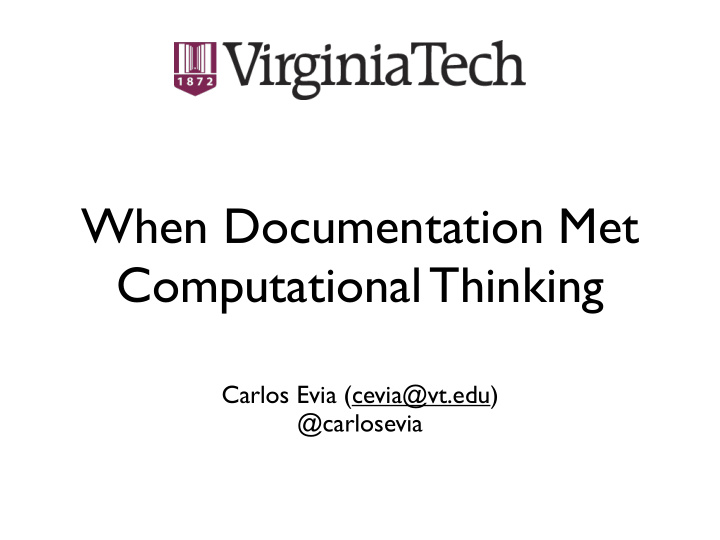



When Documentation Met Computational Thinking Carlos Evia (cevia@vt.edu) @carlosevia
The R2P genesis • IBM • Usability • XML • Task Orientation • SGML • John Carroll • US Army (Virginia Tech) • Sun/Adobe • Apple • JoAnn Hackos • Minimalism
History of 3 genres • 1984 Macintosh • 1994 JoAnn Documentation Hackos Guidelines Information Types • Learn • Concept • Use • Procedure • Reference • Reference
Document Engineering • Abstraction • Granularity
Procedural document • Is an information architecture • It works like a map • It works like a blueprint • It has directions • It has structure
Architecture A
Modules • Are specific types of information • (Some) are similar in structure... • .. and also have differences: • Learn-Use-Reference • Create many information types
Information Type I T A
Chunks=Topics • Topic is the smallest chunk of IT • Technical documents are collections of topics • SOPs have topics • Cookbooks have topics • Monkeys do not have topics
The proto topic
Topic evolution
Evolution? • Evolution • Classification systems • A common ancestor
Darwin D I T A
DITA • Darwin Information Typing Architecture • An XML grammar for engineering technical documentation • Based on topics: concept, task, and reference • No need to create <section> tags • It’s a standard
Concept • “What is?” • Explains something • Think an introduction (book or section)
Task • “How to?” • Guides through steps • The heart and soul of technical documentation
Reference • “Facts without explanation” • Use only when needed • Think codes for programming TV remote
DITA Maps • Like TOCs • But with many choices • And many outputs
Your procedural docs in DITA • Think of your documents in terms of • Concept • Task • Reference • Map DITA topic images borrowed from http://dita.xml.org/resource/5-minute-dita-tutorial
Computational Thinking • Abstraction • Automation
DITA Open Toolkit • http://dita-ot.github.io/
Silly DITA examples • http://www.carlosevia.com/CS6604/
Recommend
More recommend